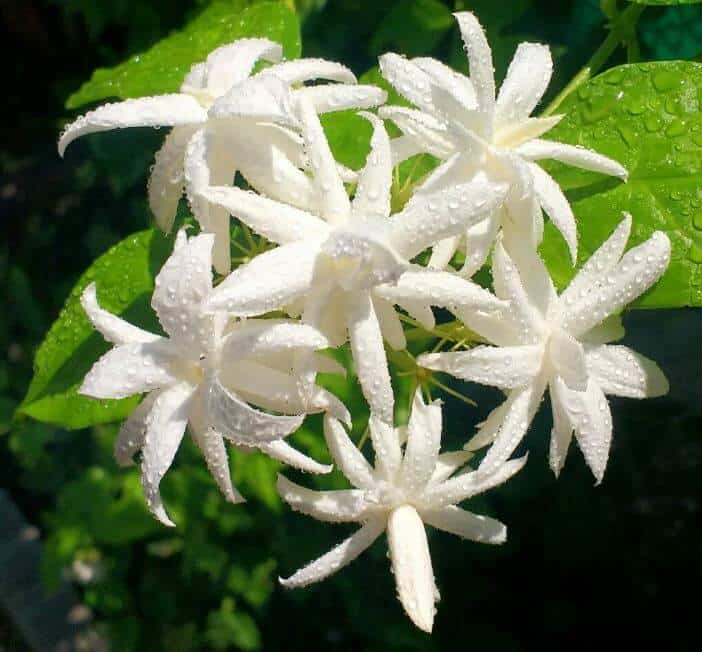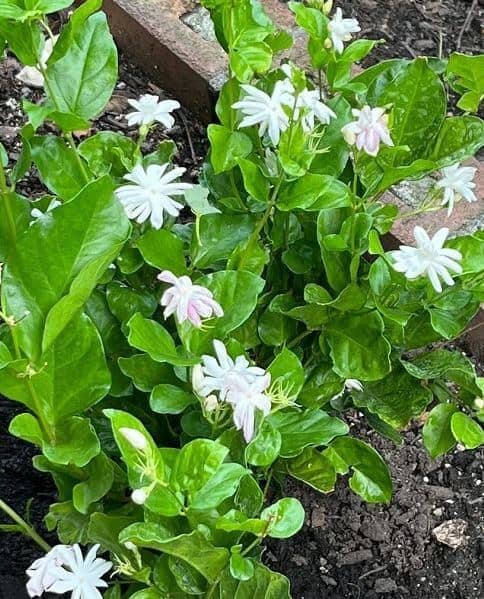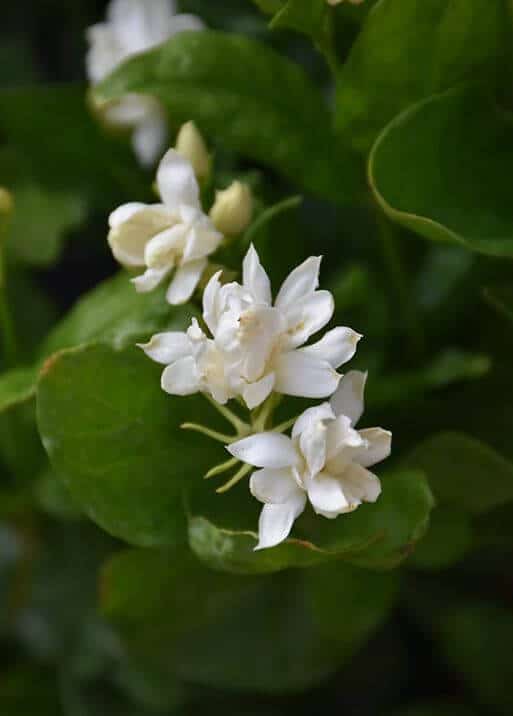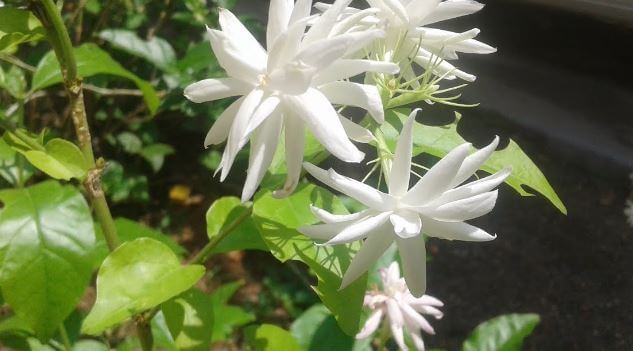Last Updated on June 4, 2023 by a Friendly Gardener
Belle of India Jasmine is a variety of Arabian Jasmine or Sambac Jasmine (Jasminum sambac) belonging to the Oleaceae or olive family and is classified under the genus Jasminum.
The species is native to tropical Asia, and you can find them growing in the region from Southeast Asia to the Indian subcontinent.
The Belle of India Jasmine plant is popular for its milky white-colored blooms that have a beautiful, heady fragrance. The fragrant flowers are commonly used as an ingredient in jasmine tea, perfumes, etc.
Here is a complete guide on how to grow the Belle of India Jasmine plant in your garden.
Belle of India Jasmine Plant Description

The Belle of India Jasmine plant is an evergreen flowering shrub or vine that is fairly fast growing and grows to a height of around 0.5 to 3 meters.
The plant has glossy, dark green oval-shaped leaves that are a lovely contrast to the milky white jasmine flowers.
The Belle of India Jasmine plant bears small star-shaped flowers in small clusters of around 3-12 flowers that appear at the ends of the branches.
The flowers bloom all through the summer and in warm climates, they may bloom all year round. The flowers have one or two layers of elongated petals and as they age, the milky white flowers turn pink.
Belle of India Jasmine Plant Care

Light
The Belle of India Jasmine plant needs full to partial sunlight for healthy growth. Ideally, the plant should get around 6 to 8 hours of sun daily if you want to get the best blooms. Although the plant can grow in shade, it will not produce as many flowers.
If you’re keeping the Belle of India Jasmine plant indoors during the winter months, then ensure that it is placed near a sunny window, where it gets ample sunlight.
Temperature and Humidity
The Belle of India Jasmine plant is native to warm and humid tropical and subtropical climates and grows best in temperatures between 59°F and 95°F.
It cannot handle cold climates and is susceptible to frost. The plant grows well in the USDA hardiness zones 9 to 11.
Soil
The Belle of India Jasmine plant grows best in loose sandy-loamy soil that contains lots of organic matter such as aged manure, compost, leaf mulch, and chopped bark. The plant does well in uniformly moist and well-draining soil.
Adding organic matter will enrich the soil and provide the nutrients required for the lush growth of the jasmine plant. And, it will also help to moisten the soil and loosen it, making it well-draining.
Water

The jasmine plant needs soil that is slightly moist at all times. The plant needs ample water during the summer months. Make sure to water the plant regularly so that the soil remains moist, but it should not be wet.
Avoid the soil from becoming soggy, as this will cause rot. Water the plant thoroughly when one to two inches of the soil is dry to the touch.
So, depending on the climate of the area where you stay, you may need to water your Belle of India Jasmine plant once a week or maybe more. Reduce the watering during the winter months.
Fertilizing
The Belle of India Jasmine plant must be fed all through the growing season as this will encourage the plant to produce more blooms. Use a balanced liquid fertilizer once in around 6 to 8 weeks. Do not fertilize the jasmine plant during winter.
Pests and Diseases
The jasmine plant is prone to pests such as scales, roundworms, and whiteflies. You can get rid of these pests by using neem oil. Prevent the soil from getting waterlogged to prevent rot and other potential diseases.
Pruning
The jasmine plant does not require a lot of pruning; however, keeping it trimmed will make the shrub look more attractive. Occasionally, remove the dead and damaged stems and leaves.
If the place where you live has a climate where the jasmine plant stops blooming in winter, then trim all the dead branches and flowers above the nodes before the winter begins.
This will ensure that the plant will have healthy growth in the next growing season.
Belle of India Jasmine Plant Propagation

It is best to propagate the Belle of India Jasmine plant by using cuttings. It is possible to grow the plant from seeds, but this is a time-consuming and long process.
From Cuttings
- Take a long cutting that is around 5 to 7 inches long from a Belle of India Jasmine plant in summer. From the cutting, remove the lower leaves and retain the top ones.
- Dip the cutting in a rooting hormone and plant it in the garden or a pot.
- Water the plant properly and ensure that it gets ample bright but indirect sunlight.
- After you plant the cutting, it will take around a couple of weeks for new shoots to appear.
From Seed
To grow the Belle of India Jasmine from a seed:
- First, soak the seeds in water for around 24 hours.
- Add moist potting soil to a seed-starting pot and place the seeds into the soil.
- Next, place a plastic bag on the pot to ensure that the moisture is retained.
- Then place the pot in a sunny area.
- Remove the plastic bag once the seedlings appear and when they are a couple of inches tall, repot the seedlings into larger pots.
Potting and Repotting the Belle of India Jasmine Plant
Generally, the Belle of India Jasmine plant does well in pots and containers. The plant needs moist but not wet soil. So, you must choose a pot with good drainage holes.
The pot must be just large enough to fit the plant well without extra space. This will prevent the soil from having excess water that can cause any issues.
If the plant fills the pot and there is no more room for it to grow, then transfer the plant into a slightly larger pot and fill the pot with new, sandy-loamy soil. Place the plant in a bright place and water adequately.
Wrapping Up

The Belle of India Jasmine plant is often grown by people in their homes for its lovely fragrant white flowers. The plant can either be trimmed and maintained as a shrub or grown as a vine using supports.
Whichever way you grow the Belle of India Jasmine plant, it is sure to make a fantastic, captivating addition to your garden, porch, or patio.

